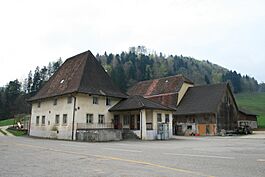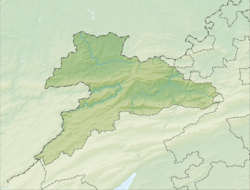Pleigne facts for kids
Quick facts for kids
Pleigne
|
||
|---|---|---|

A farm house near Lucelle village
|
||
|
||
| Country | Switzerland | |
| Canton | Jura | |
| District | Delémont | |
| Area | ||
| • Total | 17.84 km2 (6.89 sq mi) | |
| Elevation | 809 m (2,654 ft) | |
| Population
(Dec 2020 )
|
||
| • Total | 349 | |
| • Density | 19.56/km2 (50.67/sq mi) | |
| Postal code |
2807
|
|
| Surrounded by | Charmoille, Pleujouse, Bourrignon, Mettembert, Movelier, Ederswiler, Roggenburg (BL), Lucelle (F), Kiffis (F) | |
Pleigne is a small town, also called a municipality, in the Jura canton of Switzerland. It is part of the Delémont district.
Contents
History of Pleigne
Pleigne was first written about in 1179. Back then, it was called Plenna. For a while, it was also known by its German name, Pleen, but people don't use that name anymore.
Geography of Pleigne
Pleigne covers an area of about 17.83 square kilometers (6.88 square miles).
- About 47.2% of this land is used for farming.
- Nearly half, 49.2%, is covered by forests.
- Only 3.0% has buildings or roads.
- A tiny bit, 0.4%, is rivers or lakes.
- And 0.1% is land that can't be used for anything.
Most of the built-up areas are homes and other buildings (1.6%). Roads and other transport areas make up 1.2%. In the forests, 46.1% is dense forest, and 3.1% has orchards or small groups of trees. For farming, 17.4% is used for crops, 11.0% for pastures, and 18.5% for mountain pastures. All the water in Pleigne is in lakes.
The town is located on a flat area, high up at 809 meters (2,654 feet) above sea level. It is north-west of the city of Delémont. Pleigne includes the main village, many old farms from the Lucelle/Lützel Monastery, a guesthouse called Moulin-Neuf, an 18th-century mill at Bavelier, and an old archaeological site called Löwenburg.
Pleigne's Coat of Arms
The blazon (description) of Pleigne's coat of arms is quite detailed. It shows a red shield with three gold stars. In the middle, there's a silver sword and a silver staff crossed over each other. At the top, there's a small silver shield with a jay bird on it.
Population and People
Pleigne has a population of about 404 people (as of 2003). In 2008, only 2.6% of the people living there were foreign nationals. Over ten years (from 2000 to 2010), the population didn't change much. More people moved out than in, but more babies were born than people died.
Most people in Pleigne (85.0%) speak French as their main language. The second most common language is German (14.2%), and a small number (0.5%) speak Dutch.
In 2008, about 48.3% of the people were male, and 51.7% were female. Most of the people (96.9%) were Swiss citizens.
- About 49.0% of the people in Pleigne were born there.
- Another 25.5% were born in the same canton (Jura).
- 16.9% were born elsewhere in Switzerland.
- Only 3.7% were born outside Switzerland.
Looking at age groups in 2000:
- Children and teenagers (0–19 years old) made up 29.2% of the population.
- Adults (20–64 years old) were 59.6%.
- Seniors (over 64 years old) were 11.3%.
In 2000, about 49.0% of the adults were single and had never been married. About 46.0% were married. A small number were widowed or divorced.
There were 141 homes in Pleigne in 2000, with about 2.8 people living in each home. Most apartments (78.7%) were lived in all year. Some (16.7%) were used only during certain seasons, and a few (4.6%) were empty.
The chart below shows how Pleigne's population has changed over many years:

Important Heritage Sites
Some places in Pleigne are very important to Switzerland's history and culture. These are called heritage sites of national significance. They include:
- The old Priory (a type of monastery) of Löwenburg.
- An ancient settlement from the Stone Age (Paleolithic period).
- A neolithic flint mine, where people dug for stone to make tools a very long time ago.
The entire Löwenburg area is also part of the Inventory of Swiss Heritage Sites, meaning it's a special place to protect.
Economy and Jobs
In 2010, the unemployment rate in Pleigne was 3.6%. This means a small number of people who wanted jobs couldn't find them.
In 2008, there were 80 full-time jobs in Pleigne. These jobs were in different areas:
- Primary Sector: 35 jobs were in farming. This sector includes activities like growing crops and raising animals.
- Secondary Sector: 32 jobs were in this sector. Most (81.3%) were in manufacturing (making things), and 18.8% were in construction (building things).
- Tertiary Sector: 13 jobs were in this sector. This includes services like:
- Sales and car repair (23.1%)
- Moving and storing goods (38.5%)
- Hotels and restaurants (38.5%)
Many people who live in Pleigne travel to other towns for work. In 2000, 138 people left Pleigne for work, while only 38 people came into Pleigne to work. This means Pleigne sends out more workers than it brings in. Most people (55.8%) used a private car to get to work, while 9.7% used public transportation.
Religion in Pleigne
Based on information from 2000:
- About 74.8% of the people were Roman Catholic.
- 8.6% belonged to the Swiss Reformed Church (a Protestant church).
- About 8.33% belonged to other Christian churches.
- A small number (0.74%) were Islamic.
- About 6.37% said they didn't belong to any church, or were agnostic (not sure about God) or atheist (don't believe in God).
- About 5.39% did not answer the question about their religion.
Education in Pleigne
In Pleigne, about 34.1% of the people have finished upper secondary education. This is like high school, but it's not always required. Also, 8.1% have gone on to higher education, like university or a specialized college.
The school system in the Canton of Jura works like this:
- Two years of optional Kindergarten.
- Six years of Primary school.
- Three years of required lower Secondary school, where students are grouped by their skills.
- After that, students can choose to go to an optional three or four-year upper Secondary school, then to a college or university. Or, they can start an apprenticeship to learn a trade.
In the 2009-2010 school year, no students were attending school directly in Pleigne. However, 41 students from Pleigne went to schools in other towns.
See also
 In Spanish: Pleigne para niños
In Spanish: Pleigne para niños







